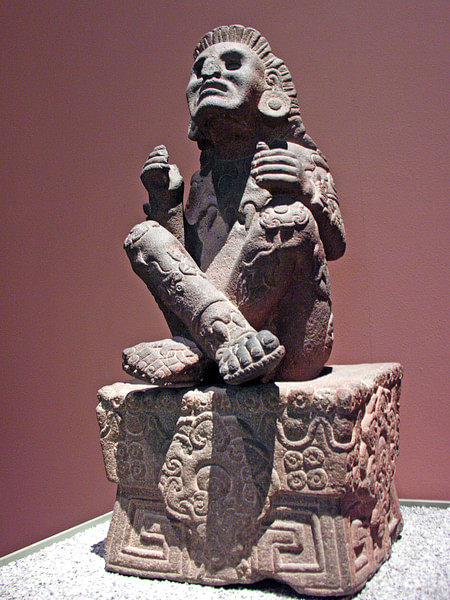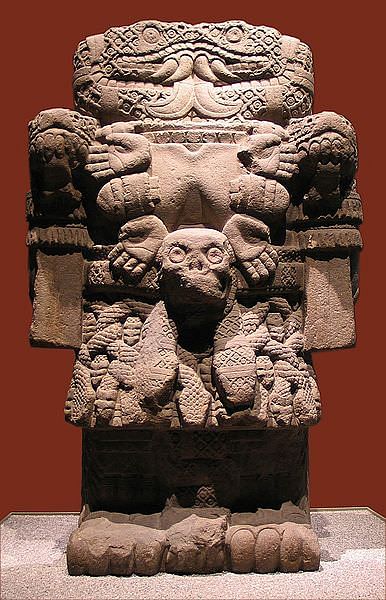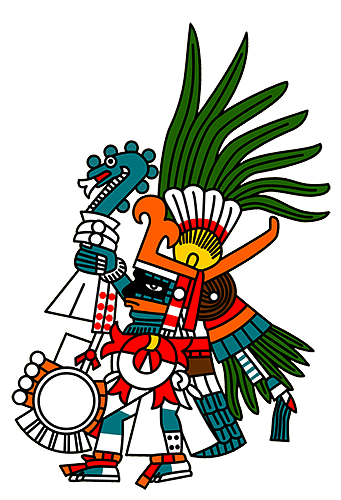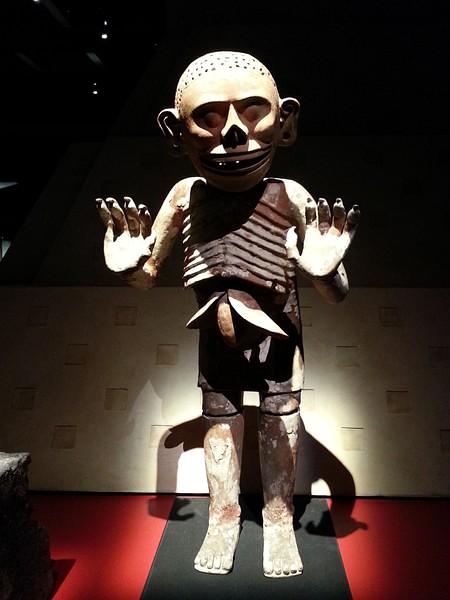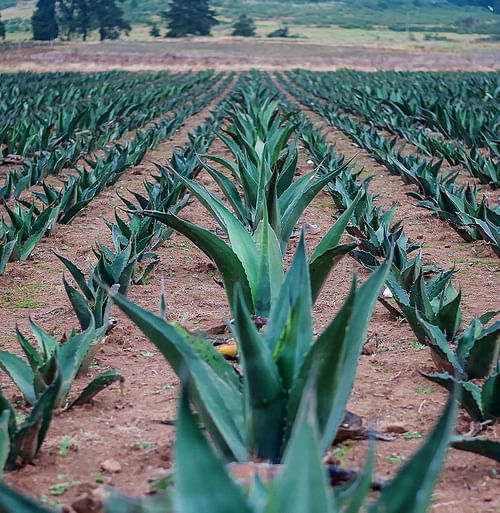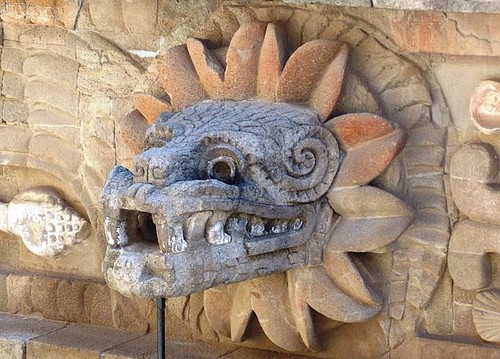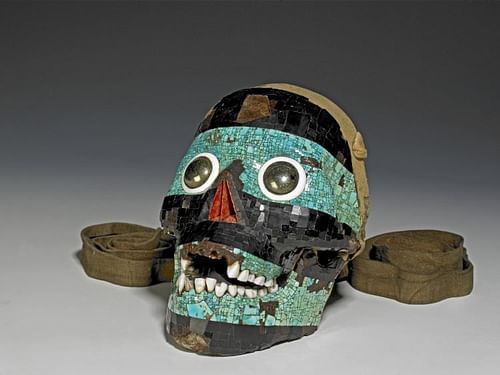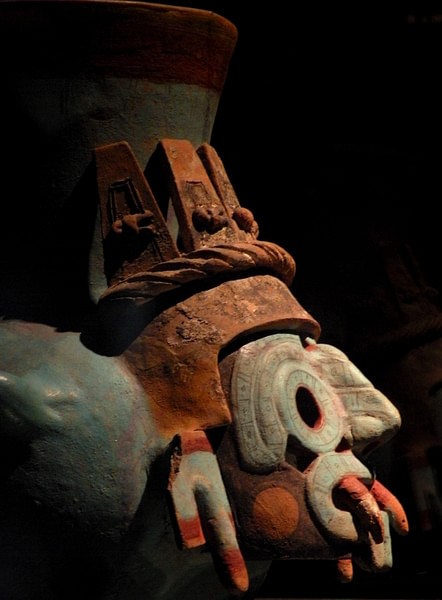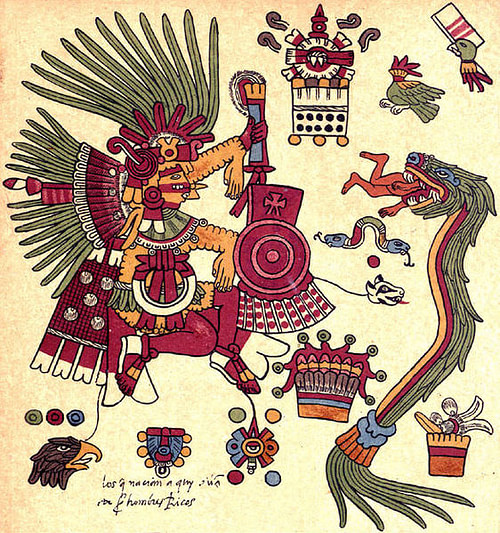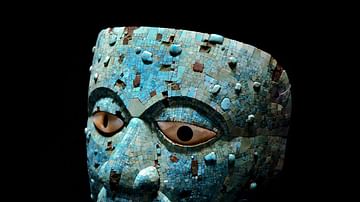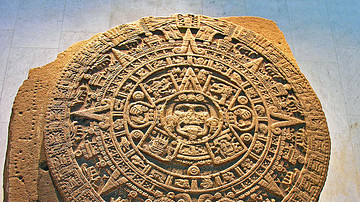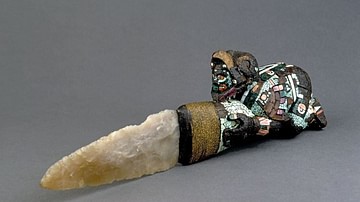The gods of the Aztecs (1345-1521 CE) were many and varied and, as with many other ancient cultures, deities were closely associated with things and events important to the culture and the general welfare of the community. These include gods of maize and the rain to nourish it, fire and the hearth to cook it, and all manner of gods to represent major celestial bodies, prominent geographical features and extreme meteorological events from the Morning Star to evening frost. Many of the gods were ancient Mesoamerican deities worshipped by the cultures preceding the Aztecs but were adopted, adapted, and assimilated into the Aztec's own unique assembly of gods and goddesses. Below is a list of the principal Aztec deities in alphabetical order.
Ahuiateotl
The god of voluptuousness and one of the Ahuiateteo. Alternatively known as Macuilxochitl or considered an aspect of Xochipilli.
Ahuiateteo
The five gods who embody the dangers of excess in eating, drinking, and pleasures in general. They each have a specific date in the annual calendar, all with a 5, a number associated with excess. They are Macuilxochitl (the most important; 5 Flower), Macuilcuetzpalin (5 Lizard), Macuilcozcacuauhtli (5 Vulture), Macuiltochtli (5 Rabbit), and Macuilmalinalli (5 Grass). In cases of excess, they can deliver misfortune and disease.
Atlatonan
An earth and water goddess.
Camaxtli
'Lord of the Chase,' a hunting god. See Mixcoatl below.
Centeotl (Cinteotl)
'Sacred Maize,' god of late-ripening maize. He was the son of Toci and associated with the 4th month, Hueytozoztli. He was the 4th of the nine Lords of the Night.
Centzon Huitznahua
Also called the Octli deities. The 400 sons of Mixcoatl who were fed to the sun and who represented the southern stars. They and their sister Coyolxauhqui had attempted to kill their mother Coatlicue but were defeated by Huitzilopochtli.
Centzon Mimixcoa
The 400 northern stars, counterparts of the Centzon Huitznahua and associated with the Milky Way.
Centzon Totochtin
The 400 rabbit gods of pulque and drunkenness. They are the offspring of Mayahuel and Patecatl and also known as the Octli deities.
Chalchiuhtecolotl
'Precious Owl,' god of the night and the black aspect of Tezcatlipoca.
Chalchiuhtlicue
'Jade Her Skirt,' goddess of the sea, rivers, lakes, and springs. Associated with the day Serpent and trecena 1 Reed. She is 3rd of the 13 Lords of the Day and 6th of the nine Lords of the Night. The Gulf of Mexico was known as Chalchiuhcueyecatl or 'Waters of Chalchiuhtlicue'.
Chalchiuhtotolin
'Precious Turkey,' an aspect of Tezcatlipoca and deity of the night and mystery. He was patron of the day Tecpatl, Flint Knife.
Chantico
'In the House,' the goddess of the hearth fire and patron of metalworkers, especially goldsmiths. Also known as Cuaxolotl.
Chicomecoatl
'Seven Serpents,' the goddess of food and especially seed corn. She was associated with the 4th month, Hueytozoztli. Celebrated on the day 7 Coatl with a feast and in the harvest festival in the 11th month, Ochpanitzli.
Cihuacoatl
'Woman Serpent,' an earth goddess associated with fertility, childbirth, midwives, and the direction west.
Citlalicue
'Star-Skirted,' goddess of the heavens and one of the several names for the Milky Way. She rules the 3rd of the 13 levels of the Aztec cosmos.
Coatlicue
'Serpent Skirt,' an earth-mother goddess associated with fertility, warfare, governance, agriculture, and patron of childbirth. She was considered the female aspect of the primordial god Ometeotl. The goddess was worshipped in the spring ritual of Tozozontli in the rainy season and in the autumnal hunting festival of Quecholli when an impersonator of the goddess was sacrificed. She is the mother of Huitzilopochtli and Coyolxauhqui.
Coyolxauhqui
'Painted With Bells,' the goddess of the Moon or Milky Way who was famously butchered by her brother Huitzilopochtli after she led the Centzon Huitznaua (the 'Four Hundred Huiztnaua' who represented the stars of the southern sky) in a bid to kill her mother, the goddess Coatlicue.
Ehecatl
'Wind and Air,' an ancient Mesoamerican god of winds, especially those which bring rain. Sometimes known as Ehecatl-Quetzalcoatl and considered the wind aspect of Quetzalcoatl. For the Aztecs, he was born on the day 9 Wind and was patron of the second day, Ehecatl. He was a creator god, and by rescuing the bones of the dead from the Underworld, he created mankind. He is sometimes credited, too, with discovering maize, pulque, and music.
Huehuecoyotl
'Old Coyote,' the ancient Mesoamerican god of dance, music, sex, cleverness, and trickery. Patron of feather workers, he was associated with the trecena 1 Flower and patron of the day Cuetzpallin.
Huehueteotl
'Old, Old Deity,' The old Fire god, often associated and represented by Xiuhtecuhtli. He was the 1st of the nine Aztec Lords of the Night and 13 Lords of the Day. He was linked to the 10th month, Xocotlhuetzi/Hueymiccailhuitl.
Huitzilopochtli
'Blue Hummingbird on the Left' or 'Hummingbird of the South,' who for the Mexica was the supreme being and son of the two primordial gods Omecίhuatl and Ometecuhtli. In an alternative version, he is the offspring of Coatlicue and brother of Quetzalcoatl, Tezcatlipoca, and Xipe Totec. He is the god of war and the sun, and patron of the Aztec capital Tenochtitlan, where he had led his people to and instructed them to settle. He was associated with gold, warriors and rulers. His calendar name was Ce Técpatl (1 Flint) and his nagual or animal spirit was the eagle. The god had a temple dedicated to him on top of the Templo Mayor at Tenochtitlan. Huitzilopochtli was worshipped in the ceremony of Panquetzaliztli in the month of the same name when the god's birth on Mt. Coatepec was commemorated, and he was also celebrated during the month of Toxcatl when a bread effigy was taken to the god's temple in a great procession and then eaten.
Huixtocihuatl
'Huixtotin Woman,' goddess of salt. She was associated with the 7th month, Tecuilhuitontli.
Ilamatecuhtli
'Old Lady,' an earth goddess associated with fertility, death and the Milky Way. She was 13th of the 13 Lords of the Day and associated with the 17th month, Tititl when a festival was held in her honour.
Itzli
'Obsidian Blade,' right-hand man of Tezcatlipoca. He was 2nd of the nine Lords of the Night.
Itzpapalotl
'Obsidian-Bladed Butterfly,' an earth goddess associated with fertility. Mother of Mixcoatl, she is patron of the day Cozcacuauhtli and the trecena 1 House.
Itztlacoliuhqui
'Obsidian Curl,' the god of snow, mountain peaks, frost and the cold. An aspect of the black Tezcatlipoca. He is patron of the day Acatl.
Ixtlilton
God of health and medicine who was the brother of Xochipilli and Macuilxochitl.
Iztaccihuatl
'White Woman,' goddess of the sacred mountain which bears her name.
Lords of the Day
See Tonalteuctin.
Lords of the Night
See Yohualteuctin.
Macuilxochitl
'Five Flower,' a god of flowers, plants, music, and dancing. Associated with the specific date 5 Flower. The patron god of the royal household, games (especially patolli and the ballgame) and gambling. He is the leader of the Ahuiateteo gods who represent excess pleasure and punishment.
Matlalcueitl
'Green Skirt,' goddess of rain and second wife of Tlaloc.
Matlalcueye
'Blue Skirt,' the goddess of the sacred mountain of that name.
Mayahuel
'Maguey,' the goddess of the Maguey plant, used to make the alcoholic drink pulque. The goddess was usually depicted as a beautiful young woman and was associated with fertility. Sometimes she is referred to as 'the woman of 400 breasts,' no doubt in reference to the milk-like sap of the plant. She is the mother of the 400 Octli Deities, consort of Patecatl, and patron of the day Tochtli (Rabbit).
Metzli
The Moon goddess.
Mictlantecacihuatl
'Mictlan Woman,' female equivalent or consort of Mictlantecuhtli.
Mictlantecuhtli
'Lord of the land of the Dead,' god of death, darkness and the Underworld (Mictlan). His wife is Mictlantecacihuatl. He was associated with owls, spiders, bats, and the direction south. The god was the ruler of the 10th day Itzcuintli (Dog), the 5th Lord of the Night and the 6th (or 11th) Lord of the Day. Mictlantecuhtli was particularly worshipped in the Aztec month of Tititl when, at the temple of Tlalxicco, an impersonator of the god was sacrificed and incense was burned in his honour.
Mixcoatl
'Cloud Serpent,' an ancient god of hunting, also known as Camaxtli, and associated with the stars, especially the Milky Way. He is the father of the Centzon Huitznahua and Quetzalcoatl. He was associated with the 14th month Quecholli when feasts and hunts were held in his honour.
Nanahuatzin
God of twins and deformities. He and his brother Tecuciztecatl sacrificed themselves to create the sun and moon of the 5th and last epoch of the Aztec cosmos.
Nappatecuhtli
One of the four directional Tlalocs gods and patron of reed mat weavers.
Octli Deities
The gods of pulque, the alcoholic beer made from the fermented juice of the maguey plant. They were also known as the Centzon Totochtin (400 Rabbits) as it was believed a rabbit had first discovered the juice of the maguey by nibbling on a leaf. They are the offspring of Mayahuel and Patecatl. Many were associated with specific towns, days, and time periods. They were also representative of drunkenness and sexual lust and so wore half-moon nose rings, a symbol of Tlazolteotl.
Omecihuatl
'Two Lady,' a primordial creator goddess. Another name for Tonacacihuatl.
Ometecuhtli
'Two Lord,' a primordial creator god. Another name for Tonacatecuhtli. He rules the 13th and highest level of the Aztec cosmos. Patron of the day Cipactli (Crocodile).
Ometeotl
'Two God,' the androgynous primordial god whose male and female aspects are Ometecuhtli and Omecihuatl.
Opochtli
'Left-handed,' one of the Tlalocs gods and protector of those who lived near water. Credited with inventing equipment for fishing such as nets and harpoons.
Patecatl
Father of the Octli Deities and god of drunkenness. His consort is Mayahuel and was also associated with medicine, herbs, and mushrooms. Patron of the day Malinalli (Grass).
Paynal
Messenger of Huitzilopochtli.
Piltzintecuhtli
The young sun god who was a manifestation of Tonatiuh, the supreme sun god of Mesoamerica. His most frequent manifestation was Xochipilli, god of summer and flowers. He is the 3rd of the nine Lords of the Night.
Popocatepetl
The god of the sacred Smoke Mountain.
Quaxolotl
'Split at the Top,' an earth goddess associated with duality.
Quetzalcoatl
'Quetzal Feathered-Serpent,' the god of winds, rains and storms who is half snake and half quetzal bird. He is the son of the primordial god Ometeotl and brother of Huitzilopochtli, Xipe Totec, and Tezcatlipoca. An ancient Mesoamerican god, he was considered the creator of the world and mankind, the discoverer of maize, and inventor of agriculture, science, the arts, and the calendar. He is the 9th of the 13 Lords of the Day. His name was adopted as part of an Aztec ruler's titles.
Quilaztli
An aspect of Cihuacoatl associated with pregnancy and childbirth.
Tecuciztecatl
A moon god and brother of Nanahuatzin. The pair sacrificed themselves to create the sun and moon of the 5th and last epoch of the Aztec cosmos. Patron of the day Miquiztli (Death).
Teoyaomiqui
The god who honoured warriors who fell in the 'Flower Wars' which gathered sacrificial victims. He was, with Mictlantecuhtli, the 6th of the 13 Lords of the Day.
Tepeyollotl (Tepeyolohtli)
'Mountain Heart,' a jaguar god of the earth's regenerative powers.
Tepictoton
'Little Old Hills,' the little Tlalocs, gods associated with mountain rain and water.
Teteoinnan
'Deities-Their-Mother,' an earth goddess associated with fertility.
Tetzcotzingo
'Bald Rock Honourable Place,' god of the sacred mountain of that name.
Tezcatlipoca
'Smoking Mirror,' the omnipotent and all-seeing god responsible for all things which happen. Also known as Ipalnemoani ('Lord of the Near'), Moyocoyani ('Maker of Himself'), Titlacauan ('We His Slaves'), Tloque Nahuaque ('Night-Wind'), and Yaotl ('Enemy'). Tezcatlipoca could be a bringer of happiness but also took on more sinister connotations when he was known as the lord of the shadows or night, a sorcerer of black magic and the bringer of evil, death, and destruction as Chalchiuhtecólotl, 'Precious Owl,' or Chalchiuhtotolin, 'Precious Turkey'. The god, being the supreme deity, was closely linked with Aztec rulers and so was a major feature of coronation ceremonies. He was especially revered at Texcoco. Tezcatlipoca was the 10th of the 13 Lords of the Day, was associated with day 1 Death, and especially worshipped during Toxcatl, the 5th month of the 18-month solar year. He was associated with the horned owl in the Mesoamerican calendar, whilst his nagual or animal spirit was the jaguar.
Tianquiztli
The gods representing the Pleiades constellation.
Tlacatzinacantli
The Aztec version of the Mesoamerican Bat-god who represented maize and fertility.
Tlahuizcalpantecuhtli
'Dawn Lord,' representing an aspect of Venus, the Morning Star, whose rays could damage both people and crops. He is 12th of the 13 Lords of the Day.
Tlaloc
'He Who is the Embodiment of Earth,' the god of rain, water, lightning, floods, droughts, and agriculture. In the Aztec Creation myth, Tlaloc was ruler of the 3rd Sun, he was linked to Mazatl (Deer), the 7th day, his calendar equivalent was 9 Ocelotl - the Jaguar, he was number 8 of the 13 Lords of the Day and 9th Lord of the Night, and his animal sign was the eagle. Tlaloc had four particular manifestations as the four colours and the four cardinal directions, collectively known as the Tlalocs. His sister is Chalchiuhtlicue (or in some versions his wife or mother), herself a goddess of rivers, oceans, and floods. Tlaloc had two wives: first Xochiquetzal, the flower and fertility goddess, but when she was abducted by Tezcatlipoca, he took a second, Matlalcueitl, another rain deity. Associated with mountains, Tlaloc was considered the ruler of the Tlaloque - a motley group of rain, weather, and mountain gods (Little Tlalocs). Tlaloc had a temple dedicated to him on top of the Templo Mayor at Tenochtitlan. The god was especially worshipped in the months of Atlcahualo (the 1st in the Aztec solar calendar), Tozoztontli (3rd) and Atemoztli (the 16th).
Tlalocan
'Place of Tlaloc,' Mt. Tlaloc, dwelling place of Tlaloc the rain god and the otherworldly paradise where victims of floods, storms, and diseases such as leprosy were received after death.
Tlalocs (Tlaloque)
'Little Tlalocs,' a group of mountain gods associated with rain and water who were ruled by Tlaloc. They represent the four cardinal directions.
Tlaltecuhtli
'Earth Lady' (although the name has a male suffix), an earth goddess associated with fertility. In mythology, Quetzalcoatl and Tezcatlipoca, in the form of snakes, ripped her body in two. From one half came the sky, and the other became the earth. She is the 2nd of the 13 Lords of the Day. She swallows the sun every evening and regurgitates it the next morning.
Tlazolteotl
'Sacred Filth,' goddess of filth and lust but also purification and cures of diseases. She was associated with the 11th month Ochpaniztli. She was patron of the day Ocelotl (Jaguar), 5th of the 13 Lords of the Day and 7th of the nine Lords of the Night.
Toci
'Grandmother,' an important earth goddess associated with fertility, warfare, cures, and the patron of midwives. She was also known as Teteo Innan ('Mother of the Gods') and Tlalli Iyollo ('Heart of the Earth'). Toci was honoured by a major harvest festival in the 11th month, Ochpaniztli.
Tonacacihuatl
'Our Flesh Woman,' a primordial creator goddess. Another name for Omecihuatl.
Tonacatecuhtli
'Our Flesh Lord,' another name for Ometecuhtli, he was a primordial creator god closely linked to procreation. He was patron of the first day Cipactli and the trecena 1 Cipactli.
Tonalteuctin
The 13 Lords of the Day and their associated 'bird':
- Xiuhtecuhtli / Huehueteotl (blue hummingbird)
- Tlaltecuhtli (green hummingbird)
- Chalchiutlicue (hawk)
- Tonatiuh (quail)
- Tlazolteotl (eagle)
- Teoyaomiqui / Mictlantecuhtli (screech owl)
- Centeotl-Xochipilli (butterfly)
- Tlaloc (eagle)
- Quetzalcoatl (turkey)
- Tezcatlipoca (horned owl)
- Mictlantecuhtli / Chalmecatecuhtli (macaw)
- Tlahuizcalpantecuhtli (quetzal)
- Ilamatecuhtli (parrot)
Tonantzin
'Honoured Mother,' an earth goddess associated with fertility. A benevolent manifestation of Cihuacoatl.
Tonatiuh
'Ascending Eagle,' the Mesoamerican Sun god who, for the Aztecs, was seen as a fierce war god.
Tzitzimime
Fierce female star demons who roamed during particular calendar and celestial events such as eclipses (when they could be seen in the sky). They devoured the unwary and, for the Aztecs, if the sun did not rise after the 52-year cycle and New Fire Ceremony, then the Tzitzimime would destroy the world.
Tzitzimitl
The 'grandmother' goddess in the sky whose demon servants are the Tzitzimime.
Xilonen
'Tender Maize,' god of the first maize and associated with the 8th month Hueytecuihuitl.
Xipe Totec
'Flayed Lord,' the god of spring, and patron god of seeds, planting, and metalworkers (especially goldsmiths) and gemstone workers. Xipe Totec was the son of the primordial androgynous god Ometeotl and the brother of Tezcatlipoca, Huitzilopochtli and Quetzalcoatl. Considered the source of diseases amongst mankind, he, nevertheless, received many offerings from worshippers calling for him to cure illnesses, especially eye ailments. He was associated with the unfavourable 15th Aztec day-name and was represented by the date 1 Ocelotl. Every spring in the second month of the solar year the festival of Tlacaxipehualiztli (aka Coailhuitl or the Snake Festival) was held in honour when war captives were skinned in symbolic imitation of the regeneration of plants and seeds which shed their husks and thereby provide new seeds.
Xiuhcoatl
The fiery snake which helps Huitzilopochtli kill Coyolxauhqui and the Centzon Huitznahua. He was associated with turquoise, grass, and the solar year, and is the emblem of the Fire god Xiuhtecuhtli.
Xiuhtecuhtli
'Turquoise Lord,' god of fire, the hearth, and time. He was closely associated with young warriors and rulers. Xiuhtecuhtli was the patron of the day Atl (water) and the trecena period 1 Coatl (Snake) and associated with the month Izcalli. He was the 1st Aztec Lord of the Night and 1st of the Lords of the Day. His nagual or animal spirit was Xiuhcoatl or the Fire Serpent, and his special number was three because in traditional Mesoamerican homes there were three hearths. One of Xiuhtecuhtli's most important roles was as overseer of the Toxiuhmolpilia festival or New Fire Ceremony. Held once every 52 years on the completion of one full cycle of the Aztec calendar, the primary function of the festival was to ensure the successful renewal of the sun.
Xochipilli
'Flower Prince,' god of summer, flowers, pleasure, love, dancing, painting, feasting, creativity, and souls. Closely associated with the corn (maize) god Centeotl, he was sometimes referred to as the 'Corn-flower Prince' or Centeotl-Xochipilli, the 7th Lord of the Day. He could also appear as Ahuiateotl, the god of voluptuousness, as something of a youthful and carefree pleasure-seeker, perhaps with a playfully mischievous streak. He has a sister (or female counterpart), Xochiquetzal. The god was associated with butterflies and poetry and the 11th of the 20 Aztec days: Ozomatli (Monkey). He was especially worshipped at Xochimilco.
Xochiquetzal
'Flower Quetzal,' a goddess of flowers, grain, pleasure, and weavers. She also protected childbirth and young mothers and was the patron of the arts in general. She was associated with the 13th month Hueypachtli (aka Tepeilhuitl) and patron of the day Xochitl (Flower) and trecena 1 Xochitl.
Xolotol
Canine god and companion of Quetzalcoatl who was associated with illness and deformity. He is patron of the day Ollin (Earthquake).
Yacatecuhtli
'Nose Lord,' god of traders and merchants.
Yohualtecuhtli
'Lord of the Night,' god of the night sun as it descended into the Underworld.
Yohualteuctin
The nine Lords of the Night and their associated augury:
- Xiuhtecuhtli / Huehueteotl (unfavourable)
- Itztli (unfavourable)
- Piltzintecuhtli-Tonatiuh (excellent)
- Centeotl (excellent)
- Mictlantecuhtli (favourable)
- Chalchiutlicue (favourable)
- Tlazolteotl (unfavourable)
- Tepeyolohtli-Tezcatlipoca (favourable)
- Tlaloc (favourable)
